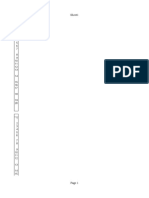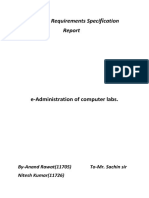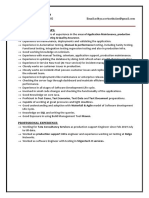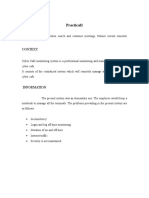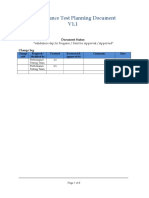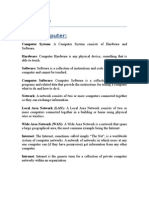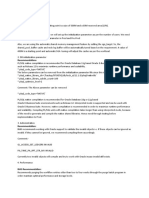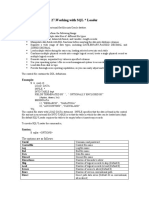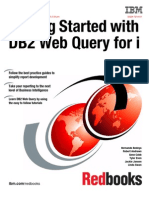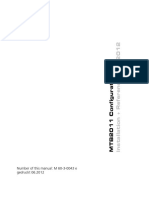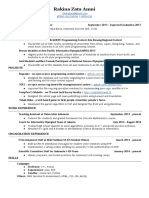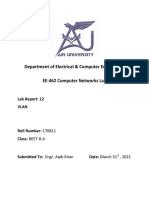DBA Environments: Development Environment
DBA Environments: Development Environment
Uploaded by
niaamCopyright:
Available Formats
DBA Environments: Development Environment
DBA Environments: Development Environment
Uploaded by
niaamOriginal Title
Copyright
Available Formats
Share this document
Did you find this document useful?
Is this content inappropriate?
Copyright:
Available Formats
DBA Environments: Development Environment
DBA Environments: Development Environment
Uploaded by
niaamCopyright:
Available Formats
DBA Environments
For a DBA, there are two types of environments
Development Environment
Production Environment
Development Environment
There are 4 stages in this environment
DEV Env.- Development
This is the starting phase of a project. The following tasks are accomplished within this period.
1. Gathering Requirements (by Project manager) 2. Prototype designing (by Project manager)
3. Screen Designing (by Programmers/Developers) 4. Coding (by Programmers/Developers) 5.
Database Designing (DBA) DBA Roles and Responsibilities in DEV Env.:
E-R Modeling
Database Design
Database Creation
Schema/table Creations
Client- Server configuration.
Coordinating the team mates to solve day-to-day issues
Attending Team
Version Control using VSS or CSS
Backup and Recovery
Tuning
SIT Env.- System Integration Test – Holds approx. 2-3 Months of DATA
After Development stage, vendors (i.e, Projects Developers/ Management) will test all the
modules for the validity (both functional and technical). If they find any issues the project will be
handed over to developers to fix those issues. The volume of data will be about 2-3 months’
approx. Here the following functions are performed. 1. Functional Testing (by project
Leads/Managers) 2. Technical Testing (by project Leads/Managers) DBA Roles and
Responsibilities in SIT Env.:
SIT Database Creation
Client- Server configuration.
Coordinating the team mates to solve day-to-day issues
Attending Team
Version Control using VSS or CSS
Backup and Recovery
Schema Refresh from SIT to DEV
Tuning
UAT Env.- User Acceptance Test – Holds approx 6-7 Months of DATA
This environment is mainly used by the PT (Performance Testing) Team. It holds 6 months data
and rigorous testing is performed. The following tasks are done in the phase of the cycle. 1.
Using WinRunner /Load Runner to do PT (by Testers) 2. Testers will report the following
DB server CPU Utilization
DB server IO Utilization
DB server Memory Utilization
Application server CPU Utilization
Application server IO Utilization
Application server Memory Utilization
Highly CPU/IO/Memory Utilized Modules
Sign OFF report if all the above is successful
DBA Roles and Responsibilities in UAT Env:
UAT Database Creation
Client- Server configuration.
Coordinating the teammates to solve day-to-day issues
Attending Team
Version Control using VSS or CSS
Backup and Recovery
Schema Refresh from UAT to SIT/DEV
Tuning
OAT Env.- Operations Acceptance Test – Holds 12 Months/Total retention period
of PROD DATA
This environment is used by Clients. It holds 1 year data or Maximum retention period of
production data. Client will test all his functionality and do PT as per his requirements. He will
provide SIGN OFF only if he is satisfied with his testing. Here the following jobs are done. 1.
Functionality and PT Done by Client 2. All the changes are documented by Vendors. 3. TCR
(Test Change Request) is implemented here. DBA Roles and Responsibilities in DEV Env.:
OAT Database Creation
Client – Server configuration.
Coordinating the team mates to solve day-to-day issues
Attending Team Meetings
Version Control using VSS or CSS
Backup and Recovery
Schema Refresh from OAT to UAT/SIT/DEV
Performance Tuning
Implementing Changes
PRD Env.- Production environment- 12 Months/Total retention period of PROD
DATA
This environment is used by Customers/end users of the Client. It holds 1 year data or
maximum retention period of client’s requirement. Testing is no more performed in the
environment. This holds real data from the customer/client. This environment will be handled by
Client’s DBA or Production DBA. The DBA is responsible for the following activities: 1.
Functional and PT Done by Client 2. All the changes are documented by Client DBA/Production
DBA. 3. PCR (Production Change Request) is implemented here. DBA Roles and
Responsibilities in DEV Env.:
PRD Database Creation
Client – Server configuration.
Attending Team Meetings
Version Control using VSS or CSS
Backup and Recovery
Schema Refresh from OAT to UAT/SIT/DEV
Performance Tuning
Implementing Changes
PRODUCTION Environment
There will be more than 2000 databases to be handled. Generally, these databases will be in
data centers. The DBAs will work on 24X7 shifts to maintain these databases. The DBAs may
work from Client’s place, Data Center or even connect from home. DBAs might sit in different
locations and they may get the requests through emails or in the form of tickets. Requests are
also called as tickets, work orders, tasks etc. In most cases, DBAs work in shift and they work
from various geographical locations. If the DBAs get requests through mail, they will discuss via
chat (chat software like ibm -same time or mind-align etc) and assign the request among
themselves. In some organizations they use ticketing software like remedy where the DBAs can
assign tickets/requests within themselves or a Team lead will assign the tickets to any of them
randomly. Once the request is completed the dba will close the tickets. Once the shift time
(normally 8 hrs) of a DBA is over and if he has a task to perform that takes about 3 hours, the
task is handed over to the colleague of the subsequent shift and it is called ‘Hand Over’ The
general terms that is used
Severity tickets(sev-1, sev-2, sev-3, sev-4)
Sev 1 : Highly Critical database issues like DB has gone down or a customer is
stuck with some critical issues. DBAs show attend and try to solve immediately (ie. to provide
high priority on this ticket) . Also after solving , must do RCA(root cause analysis). Most of the
organizations with have a con-call with client and vendors and explain the cause. This con-call
is called RCA call.
Sev 2 : The duration to attend the ticket varies for different clients say around 2
to 8 hrs. .For instance, a sql patch execution or tablespace going may exceed 85% or 90% with
in 2 hrs and so on.
Sev 3 : The duration allowed may be from 1 to 2 days. This also depends on the
clients. Example: adding mount points, adding new users, Schema refresh, DB refresh etc.
Sev 4 : The duration may be with in a week. Example: request of new database,
additional need of SAN/NAS space etc.
GOLIVE – production implementation
SIGN OFF - acceptance certificate/mail from client.
HANDSHAKE – handing over the incomplete job to another dba after shift timing.
WINDOW TIME – maintenance time for database.
BOUNCE DB - restart the database.
SLA – Service level agreement. Agreement between client and vendor.
CLIENT – Who gives work/project
VENDOR- Who does the service.
What are the types of severity ?
Thanks : http://www.oracle.com/technetwork/articles/haskins-rac-project-guide-
099429.html
Severity-Level Resolution
Tier Performance Availability
Description Requirement
Normal operation System is responding System is 100% None
5 at normal operating available. All outages
baseline. are properly scheduled.
Severity level 4: Performance is 10% 90% to 95% of the Must be resolved
Trivial problem to 30% below the applications or within five days
4 with little or no required baseline. application
impact functionality is
available.
Severity level 3: Performance is 30% 85% to 90% of the Must be resolved
Minor problem to 50% below the applications or within three days
3 with minimal required baseline. application
impact functionality is
available.
Severity level 2: Performance is 50% 80% to 85% of the Must be resolved
Noticeable to 70% below the applications or within one day
2 problem with required baseline. application
measurable functionality is
impact available.
Severity level 1: Performance is 70% 75% or less of the Must be resolved
Severe problem or more below the applications or within three hours
1 with high business required baseline. application
impact functionality is
available.
Generally, there will be only 4 type of severity(Sev-1,Sev-2,Sev-3,Sev-4). Sev-5 is rarely
considered.
In the resolution requirement the days may vary between companies.
You might also like
- Apache Cassandra Administrator Associate - Exam Practice TestsFrom EverandApache Cassandra Administrator Associate - Exam Practice TestsNo ratings yet
- Manual Testing Interview QuestionsDocument36 pagesManual Testing Interview QuestionsCorythiaNo ratings yet
- 2azure Machine Learning Final TestDocument9 pages2azure Machine Learning Final TestRoberto AyalaNo ratings yet
- DBA Services SOWDocument11 pagesDBA Services SOWDeepak AnuNo ratings yet
- Manual Testing Interview Question-01Document25 pagesManual Testing Interview Question-01svuhariNo ratings yet
- Performance Test Approach For SAP SaaSDocument5 pagesPerformance Test Approach For SAP SaaSSandeep PandeyNo ratings yet
- RedDwarf Server Application TutorialDocument33 pagesRedDwarf Server Application TutorialninhydrinalNo ratings yet
- Why Use Iteration/Incremental Model?Document4 pagesWhy Use Iteration/Incremental Model?Koh TongyiNo ratings yet
- Software Requirements SpecificationDocument21 pagesSoftware Requirements SpecificationBlack starNo ratings yet
- What Is SRSDocument13 pagesWhat Is SRSrashmikant2009No ratings yet
- Basic Interview Questions For Manual TestingDocument21 pagesBasic Interview Questions For Manual TestingrajisgoodNo ratings yet
- OnlineExaminationQuiz/Report/Final Online Examination Porject ReportDocument71 pagesOnlineExaminationQuiz/Report/Final Online Examination Porject ReportAnjan HRNo ratings yet
- Aditya ResumeDocument5 pagesAditya ResumeadityaNo ratings yet
- What Is Client-Server and Web Based Testing and How To Test These ApplicationsDocument9 pagesWhat Is Client-Server and Web Based Testing and How To Test These ApplicationssvelamaNo ratings yet
- Rollout Management-Part 1: 1. PlanningDocument14 pagesRollout Management-Part 1: 1. Planningec_firmatNo ratings yet
- Manual Testing Interview Question by Shammi JhaDocument25 pagesManual Testing Interview Question by Shammi Jhaanilprasadallu100% (7)
- Testing Interview QuestionDocument24 pagesTesting Interview QuestionKhajakhaleelullah ShaikNo ratings yet
- WINSEM2023-24 BCSE301P LO VL2023240502898 2024-01-04 Reference-Material-IDocument19 pagesWINSEM2023-24 BCSE301P LO VL2023240502898 2024-01-04 Reference-Material-ILOVE YADAVNo ratings yet
- Pravin Kumar Mobile: +91 9945315980 Professional SummaryDocument4 pagesPravin Kumar Mobile: +91 9945315980 Professional Summarypravin216No ratings yet
- LabManual SEDocument50 pagesLabManual SEshahNo ratings yet
- LabManual SEDocument50 pagesLabManual SEshahNo ratings yet
- DemoPurposeOnlyPerformanceTest PlanDocument9 pagesDemoPurposeOnlyPerformanceTest Planraja gouravNo ratings yet
- Requirement Analysis: 2.1 Functional RequirementsDocument4 pagesRequirement Analysis: 2.1 Functional RequirementsAarthi shindeNo ratings yet
- PL SQL Interview QnsDocument182 pagesPL SQL Interview Qnsmustafa2376100% (1)
- Naga Sridevi: Email: Phone: 9032314870Document3 pagesNaga Sridevi: Email: Phone: 9032314870Nagaraju kattaNo ratings yet
- SLADocument4 pagesSLADevaraj Ghatualo100% (1)
- Essence of Performance and Load Testing VanQ 30 April 2009Document42 pagesEssence of Performance and Load Testing VanQ 30 April 2009Khushboo TambiNo ratings yet
- Software Evolution Is A Term Which Refers To The Process ofDocument2 pagesSoftware Evolution Is A Term Which Refers To The Process ofsusvi85No ratings yet
- MCS-034 Solved AssignmentsDocument30 pagesMCS-034 Solved AssignmentsAbhinand Rajeev SNo ratings yet
- Manual Testing Interview PreparationDocument38 pagesManual Testing Interview PreparationMan ModiNo ratings yet
- Saturday: Basic ComputerDocument10 pagesSaturday: Basic ComputerSopno NonditaNo ratings yet
- Guided By: Mr. Alwin Pinakas Submitted By: M.SIVAKUMAR 08MCA47 !!!RD MCA ' A'Document21 pagesGuided By: Mr. Alwin Pinakas Submitted By: M.SIVAKUMAR 08MCA47 !!!RD MCA ' A'Deepak ShergeilNo ratings yet
- Objectives and ScopeDocument9 pagesObjectives and Scopedewang goelNo ratings yet
- Manual TestingDocument57 pagesManual TestingsoujanyaadaviNo ratings yet
- Santosh KumarDocument4 pagesSantosh KumarNagaraju kNo ratings yet
- Manual Testing Interview Quesions and AnswersDocument35 pagesManual Testing Interview Quesions and AnswersGajapathi VJNo ratings yet
- CART Testing PlanDocument15 pagesCART Testing Planmatellor2No ratings yet
- Knowledge Database Support Tool: Title Description/ PurposeDocument7 pagesKnowledge Database Support Tool: Title Description/ Purposevisha_sNo ratings yet
- PL-500 Exam Free Actual QampAs Page 11Document5 pagesPL-500 Exam Free Actual QampAs Page 11unit3 misNo ratings yet
- Letter HodDocument7 pagesLetter Hodapi-3862218No ratings yet
- SDLCDocument32 pagesSDLCNijith NTNo ratings yet
- A Secure Atmosphere For Web Storage and Transfer - CYBERSPACEDocument110 pagesA Secure Atmosphere For Web Storage and Transfer - CYBERSPACEsathishNo ratings yet
- Unit2 SEDocument21 pagesUnit2 SEankitgupta0429No ratings yet
- Test Execution and Defect ManagementDocument36 pagesTest Execution and Defect Managementmannd211No ratings yet
- Python 3Document22 pagesPython 3kshitijsingh2500No ratings yet
- CBDT3103 AnswerDocument9 pagesCBDT3103 AnswerRyan JeeNo ratings yet
- SAP Basis Brown-Bag Session Part - BDocument18 pagesSAP Basis Brown-Bag Session Part - BRohitSinghBishtNo ratings yet
- Performance TestingDocument20 pagesPerformance Testingcepl34No ratings yet
- Software/Web Testing Questions and AnswersDocument59 pagesSoftware/Web Testing Questions and AnswersamarlolageNo ratings yet
- Synopsis FinalDocument43 pagesSynopsis Finaltusharjagwan2004No ratings yet
- RE: What Document We Need For QA / QC / Testing: Data IntegrityDocument18 pagesRE: What Document We Need For QA / QC / Testing: Data Integrityapi-19820505No ratings yet
- TemplateDocument19 pagesTemplatengttchangNo ratings yet
- ResumeDocument5 pagesResumerrcrajesh2003No ratings yet
- ManualDocument14 pagesManualsanthoshNo ratings yet
- Sourav Synopsis FinalDocument43 pagesSourav Synopsis FinalMANISH KUMARNo ratings yet
- Software Development Life Cycle (SDLC)Document38 pagesSoftware Development Life Cycle (SDLC)Varun DhimanNo ratings yet
- S 285 Risk Qualification InfstructureDocument10 pagesS 285 Risk Qualification InfstructureMohamed SallamNo ratings yet
- Performance Testing Tutorial - Learn With Its Types and ExamplesDocument11 pagesPerformance Testing Tutorial - Learn With Its Types and ExamplesGTS SS DRSCNo ratings yet
- PL SQL Interview QnsDocument182 pagesPL SQL Interview QnsChandra Babu Naidu VeluriNo ratings yet
- Software Testing Interview Questions You'll Most Likely Be AskedFrom EverandSoftware Testing Interview Questions You'll Most Likely Be AskedNo ratings yet
- SQL Server Security (Logins, Users - Fixed Roles)Document3 pagesSQL Server Security (Logins, Users - Fixed Roles)niaamNo ratings yet
- SQL DBA Training1Document7 pagesSQL DBA Training1niaamNo ratings yet
- Concurrent Manager Checklist: Important FilesDocument2 pagesConcurrent Manager Checklist: Important FilesniaamNo ratings yet
- Form Server ChecklistDocument1 pageForm Server ChecklistniaamNo ratings yet
- ASM Cheat SheetDocument9 pagesASM Cheat SheetniaamNo ratings yet
- R12.2.8 Command Center NotesDocument5 pagesR12.2.8 Command Center NotesniaamNo ratings yet
- Appworld: Lab Exercises For Oracle Apps File SystemDocument1 pageAppworld: Lab Exercises For Oracle Apps File SystemniaamNo ratings yet
- Creating Custom Application: Adovars - EnvDocument2 pagesCreating Custom Application: Adovars - EnvniaamNo ratings yet
- Notice: Technical Note XXXX: Integrating Oracle BI Applications With Oracle E-Business SuiteDocument13 pagesNotice: Technical Note XXXX: Integrating Oracle BI Applications With Oracle E-Business SuiteniaamNo ratings yet
- Row Migration N ChainingDocument18 pagesRow Migration N ChainingniaamNo ratings yet
- BIAS Recommended SettingsDocument6 pagesBIAS Recommended SettingsniaamNo ratings yet
- Errors Reported in Alert - Log of PRODUCTION On April 7thDocument2 pagesErrors Reported in Alert - Log of PRODUCTION On April 7thniaamNo ratings yet
- Scripts Upload ScriptsDocument5 pagesScripts Upload ScriptsniaamNo ratings yet
- 27.working With SQL LoaderDocument4 pages27.working With SQL LoaderniaamNo ratings yet
- Role of A Database AdministratorDocument1 pageRole of A Database AdministratorniaamNo ratings yet
- 4.1DB CreationDocument2 pages4.1DB CreationniaamNo ratings yet
- Onvue Technical Requirements: Exam Delivery MachineDocument5 pagesOnvue Technical Requirements: Exam Delivery MachineniaamNo ratings yet
- Cary Eclipse Fluorescence Preventive Maintenance Scope of WorkDocument10 pagesCary Eclipse Fluorescence Preventive Maintenance Scope of WorkRubia BottiniNo ratings yet
- Dang Minh Sang: Project Manager Cum Technology & Innovation ConsultantDocument2 pagesDang Minh Sang: Project Manager Cum Technology & Innovation Consultantviet gapNo ratings yet
- Power Supply For 8051 MicrocontrollerDocument5 pagesPower Supply For 8051 MicrocontrollerAshok Ekanath KalangeNo ratings yet
- Writing A Descriptive Essay On A Person / Place / Festival / Event / ExperienceDocument17 pagesWriting A Descriptive Essay On A Person / Place / Festival / Event / ExperienceChaimae Sweet100% (1)
- Ibm Redbook - Db2 Web QueryDocument606 pagesIbm Redbook - Db2 Web QueryLissa VolsonNo ratings yet
- Altivar Machine ATV320 - ATV320U15N4CDocument10 pagesAltivar Machine ATV320 - ATV320U15N4CKakmuza ZainNo ratings yet
- "ZNR" Transient/Surge Absorbers: Recommended Applications FeaturesDocument20 pages"ZNR" Transient/Surge Absorbers: Recommended Applications FeaturesFacundo FernandezNo ratings yet
- FilterDocument7 pagesFilterThắng NguyễnNo ratings yet
- RajakDocument7 pagesRajakBhin BhinNo ratings yet
- Number of This Manual: M 60-3-0043 e Gedruckt 06.2012Document90 pagesNumber of This Manual: M 60-3-0043 e Gedruckt 06.2012andrew glidleNo ratings yet
- Module 4 - Implementing Network Security NewDocument76 pagesModule 4 - Implementing Network Security Newtroll masterNo ratings yet
- 750com In001 - en PDocument4 pages750com In001 - en POmar FerretizNo ratings yet
- Resume - Rakina Zata AmniDocument1 pageResume - Rakina Zata AmniFaza InsanNo ratings yet
- Department of Electrical & Computer Engineering EE-462 Computer Networks LabDocument34 pagesDepartment of Electrical & Computer Engineering EE-462 Computer Networks LabbushrabatoolNo ratings yet
- Recipe Database UserManual enDocument25 pagesRecipe Database UserManual enFarhan AnwarNo ratings yet
- Galerkin's Method: APL705 Finite Element MethodDocument3 pagesGalerkin's Method: APL705 Finite Element MethodakashNo ratings yet
- Set No: 1: Code No: V3203/R07Document50 pagesSet No: 1: Code No: V3203/R07Polireddi Gopala KrishnaNo ratings yet
- Ableton File ManagementDocument3 pagesAbleton File ManagementDan JosephNo ratings yet
- Artificial Intelligence-Based Power Transformer Health Index For Handling Data UncertaintyDocument12 pagesArtificial Intelligence-Based Power Transformer Health Index For Handling Data UncertaintyHashirama SenjuNo ratings yet
- Operating System Design: DouglasDocument13 pagesOperating System Design: Douglasseetaram dantuNo ratings yet
- DM QBDocument10 pagesDM QBSelva RajNo ratings yet
- Cisco Vs Juniper ComparativeDocument1 pageCisco Vs Juniper ComparativeReynaldo RossiNo ratings yet
- Math Primary 2 Spring 2023 Practice Paper (English) PDFDocument29 pagesMath Primary 2 Spring 2023 Practice Paper (English) PDFBarkah Hani Pramesti100% (4)
- Set 1 Photoshop Mcq'sDocument7 pagesSet 1 Photoshop Mcq'skamaljit kaurNo ratings yet
- Notification UMC May-June 2023 (Offline Meeting)Document6 pagesNotification UMC May-June 2023 (Offline Meeting)imyadashuNo ratings yet
- Manual: Auto Transfer ControllerDocument32 pagesManual: Auto Transfer ControllerAung Mh100% (1)
- Conducted and WirelessDocument20 pagesConducted and WirelessRyan Arinzol OlaybalNo ratings yet
- Tier IV RFP Uptime Institute 18012018Document64 pagesTier IV RFP Uptime Institute 18012018kumarNo ratings yet
- Mil STD 471aDocument64 pagesMil STD 471aLaura Encinas EscobarNo ratings yet


